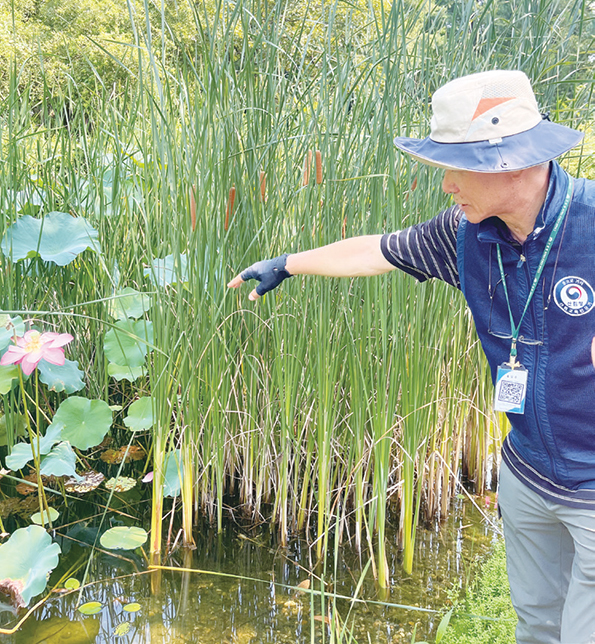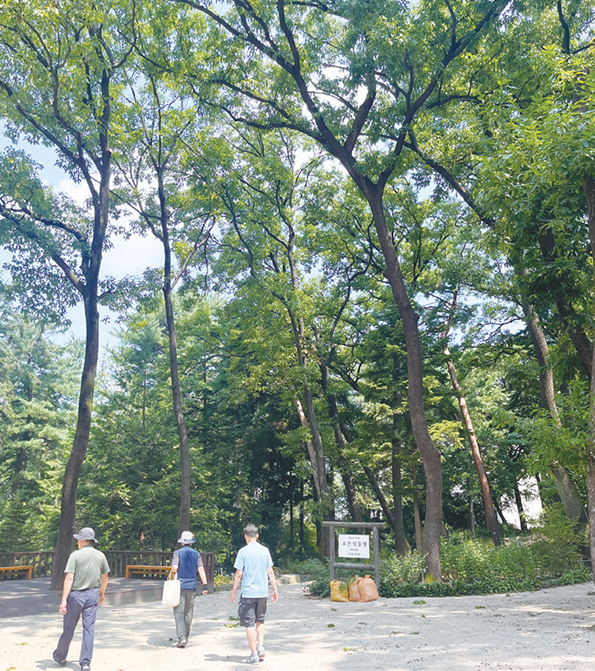The Chungbuk Times > Global > View
Forest Therapy In The City!
力 217 龋 惯青老 : 2024.09.02

Forests are crucial resources that perform multi-purpose functions such as maintaining agricultural productivity and preserving land, providing and protecting wildlife habitats, and supplying places for rest. In particular, forests play a major role in allowing people to experience nature and find sufficient rest even in the city. This aspect of a forest is clearly high demand in a stressful work environment today. CBT reporters visited the Hongneung Experimental Forest to restore life balance and feel relaxed on their own through the forest despite busy daily lives.
The Hongneung Experimental Forest, named after the grave of Empress Myeongseong (the 26th queen of Emperor Gojong), was established in 1922 as Korea’s first forestry site. It is currently located in Hoegi-ro, Dongdaemun-gu, Seoul, at the National Institute of Forest Science (NIFoS), the only national forest research institution in Korea. Moreover, the Hongneung Experimental Forest has high historical, cultural, and academic value in that it is the first test site for modern forestry testing. Currently, coniferous, broadleaf, herbaceous, and shrub gardens are built on an area of about 41.8 hectares, and various animals and plants cohabitate the forest.
Since 1993, the forest has been opened the public and is used as a resting place, educational center, and urban forest. There is a restriction on viewing some areas because it is not purely a public forest, but a research facility of the state. The forest is closed every Monday, and visitors can only participate in the Hongneung Experimental Forest Commentary Program with forest commentators from Tuesday to Friday. The forest has also been partially opened the public on weekends to raise public awareness of forest science and environment. No reservations are required over the weekend. The Hongneung Experimental Forest Commentary Program is available on the website, www.foresttrip.go.kr. Reservations can be made every month, and up to 80 visitors can participate together. The program takes about an hour and 40 minutes to complete and runs three times daily at 10:30, 13:30, and 15:30. CBT reporters participated in the program with Song Won-hyuk, a forest commentator.
The Hongneung Experimental Forest is divided into eight areas from Garden グ to Garden シ. Due to time restriction, CBT could only visit three of them. Before embarking on the full-fledged tour, visitors apply mosquito repellent to exposed parts of their bodies, such as arms and legs, in preparation for encountering mosquitoes in the forest. First, Song Won-hyuk, the aforementioned forest commentator, warmly welcomed participants and provided a brief history of the Hongneung Experimental Forest. It was during the Japanese colonial era that forestry-related research began for the first time here, where the Hongneung Experimental Forest is currently located. For the Japanese to use plant resources on the Korean Peninsula, the headquarters of the forestry test site was established here to investigate and study forest resources. After Korea’s liberation from Japan, the forest became the current national research institution.
Gardenグ(Conifers & Medicinal Plants Garden)

The viewing started at the Garden グ left of the main entrance. In line with the name Hongneung “Experimental” Forest, the plant resources here are not just for viewing but are all state-controlled plants that are studied for a specific purpose. Visitors were drawn to the forest not only for the opportunity to observe various plant resources in a compact but also because they can encounter rare species that are otherwise hard to find. The medicinal plants garden in the Garden グ has 192 species of 59 families and has many specimens for forestry experiments. Furthermore, it is characterized by a wide variety of trees, including Lagerstroemia indica, coniferous trees, pine, Taxus cuspidata, and Caragana sinica, growing in a small area. In particular, the commentator gave a detailed explaination about Caragana sinica, showing that grass is resposible for bones based in the Chinese characters. The name in Chinese characters, 烷咏醍, 醍 can be thought of as grass, but Caragana sinica is a tree. It is characterized by the fact that two small leaves on the left and right form a large leaf, and it has a sting. In Traditional Korean Medicine, Caragana sinica dried in the sun is used as a medicinal herb because it is effective for neuralgia when the patella is sore or the legs swollen. In a small pond in front of the medicinal plants garden, the commentator told visitors how to distinguish between male and female red dragonflies and stories about lotus flowers, water lilies, and Lythrum anceps. On July 15 by the lunar calendar, on Buddhist All Souls’ Day, monks held a memorial service in front of the Buddha. At this time, the flowers offered to the Buddha should be lotus flowers, which are precious and difficult to get, so monks devoted Lythrum anceps, which are relatively easy to get from local wildflowers in Korea.
Garden ゲ (Deciduous Garden)

After looking around Garden グ, the reporters and visitors entered the Garden ゲ which has 195 species of 40 families. It holds a collection of Deciduous trees that have been planted around the 1920s. Due to time restrictions, only a few representative species were observed, and among them, the Alnus japonica was impressive. It is 20 meters high, has a fast growth velocity and a long life span. In Korean, Alnus japonica is referred to as 5-ri tree, which means about 2 kilometers. It was planted every 2 kilometers so that people would not get lost in the forest in the past. During their visit, the reporters observed the Diospyros lotus, often considered the “mother” of persimmon trees, which serves as the foundational tree for grafting persimmons. Through generations of propagation, persimmon trees have been sustained by grafting branches from Diospyros lotus as an understock. Additionally, the forest was adorned with abundant autumn leaves, including Euonymus alatus, Citrus trifoliata, Morning Glory, Celosia argentea, and Liriope muscari, creating a vibrant natural atmosphere.
Garden コ (Deciduous Garden)
After passing through the main building on the north side of Garden ゲ, the reporters arrived at Garden コ and listened to the final commentary. Garden コ holds a collection of 67 species from 26 families of Deciduous trees, including six standard species of oak tree, Quercus acutissima, Quercus variabilis, Quercus mongolica, Quercus dentata, Quercus aliena and Quercus serrata, which are the basic species of Korean oak tree. In addition, the reporters saw Berchemia berchemiifolia with oval leaves, Acer pictum var. mono used for food by collecting sap, and Chionanthus retusus covered with white flowers. After leaving Garden コ, we saw Pinus densiflora for. multicaulis Uyeki planted on the lawn behind the main building. It was replanted in 1923, moving the 30 years old Pinus densiflora for. multicaulis Uyeki adjacent to the Hongneung Elementary School, and is the longest-lived tree and living proof of the Hongneung Experimental Forest. The stalk was about 1 meter above the ground, and the thick branches were divided into several branches making visitors wonder.
While participating in the Hongneung Experimental Forest Commentary Program, the reporters were able to learn more about the value of nature better while enjoying the breeze feeling in the shade in the hot and humid weather of over 34 degrees Celsius. The Hongneung Experimental Forest, which allowed people to step on the refreshing forest path, made it possible to experience forest therapy. Moreover, the reporters are thankful for the fact that nature has settled in the city surrounded by numerous people and artificial buildings. In addition, Song Won-hyuk’s forest commentary program, which told visitors the names of the small insects on their clothes and their meanings, and taught visitors the importance of all life, was meaningful in itself. Free viewing over the weekend will also offer another attraction, but the forest commentary program will provide time to experience the value of the urban forests and the need for a conversation about protecting forests. Why do not you also visit the Hongneung Experimental Forest and take a rest in the forest while breathing the clear air full of the smell of soil and grass?
By Jeong Ha-yeon
hayeon0330@chungbuk.ac.kr
By Kim Seo-yeon
ssung@chungbuk.ac.kr